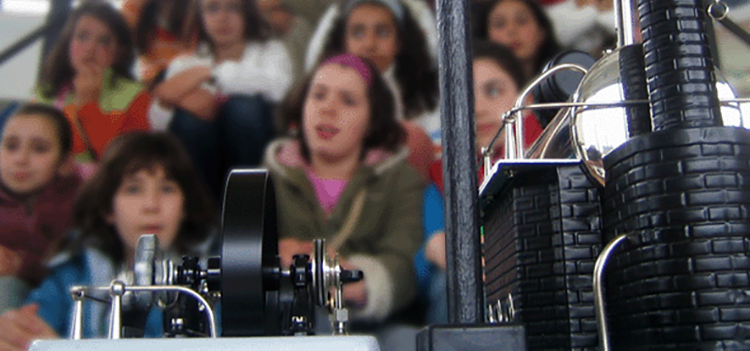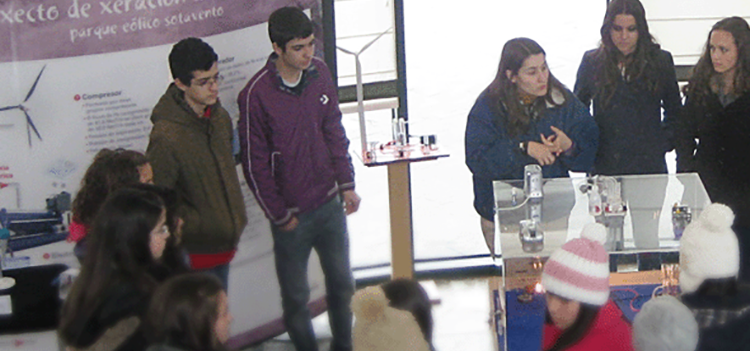Organisational group objectives
The Sotavento Educational -Training Program is aimed at all levels and organisational groups. Any association, company, central primary, secondary or vocational schools, universities, groups or individuals with an interest in renewable energy and energy efficiency can arrange a visit to our facility.
For each visit, a specific program is created that is tailored to the interests, level of training and enquiries of its participants and which aims to meet, in general, the following objectives:
Educational and training centres

OBJECTIVES:
- Recognise the concept of energy and the different ways it has been used throughout history
- Learn different ways to get energy and understand the difference between renewable energy sources and non-renewable energy sources
- Observe the applicability of the various renewable energy sources
- Be aware that energy production makes an impact on the environment
- Appreciate the importance of energy in our lives and the need to use it responsibly
CONTENTS:
- Energy throughout history
- Distinction between different ways of using energy throughout history
- Recognition of basic concepts related to energy
- Energy sources:
- Non-renewable: uranium, oil, gas and coal
- Renewable: the sun, the sea, the rivers, the wind, the heat of the earth, biomass
- Differentiation of renewable and non-renewable energy sources
- Awareness of the transformation of renewable energy sources present within nature into electricity and heat
- Observation and differentiation of the parts of a wind turbine and its operation
- Observation and testing of the wind’s ability to produce energy
- Energy balance
- Energy saving and efficiency
- Awareness of the importance of energy in everyday life and the sources we use to get it
- Recognition of the relationship between energy use and environmental impact
- Awareness of the need to mitigate the environmental impact that occurs when consuming energy
- Introduction to electric mobility
- Identifying actions for the responsible use of energy in everyday life and especially in our homes
- Thirst for knowledge and care for our environment

OBJECTIVES:
- To learn the traditional ways of harnessing energy and its evolution throughout history
- To understand and analyse the sources of renewable and non-renewable energy and its main features
- To understand and analyse the energy balance at national, European and global levels
- To understand the operation of a wind farm in its various phases: assembly, production and disposal
- To understand the use of the sun as an energy source in its different aspects: the operation of a solar heating panel and solar photovoltaic panel
- To understand research projects carried out at Sotavento such as Wind Energy Accumulation as H2
- To understand the importance of bioclimatic architecture in energy saving
- To observe the applicability of the various sources of renewable energy in everyday life, comparing their performance and energy efficiency
- To reflect on the impact of human activities on our environment
- To be aware of the need for responsible and efficient energy consumption
CONTENTS:
- Energy throughout history
- Distinction between different ways of using energy throughout history
- Recognition of basic concepts related to energy
- Energy sources:
- Non-renewable: uranium, oil, gas and coal
- Renewable: the sun, the sea, the rivers, the wind, the heat of the earth, biomass
- Analysis of renewable and non-renewable energy sources, and their main features
- Analysis of the transformation of renewable energy sources present within nature into electricity and heat
- Awareness of the importance of energy in everyday life and the environmental cost involved
- Reflection and critical approach to the use and performance of energy sources
- Knowledge of the installation and operation of a wind farm, previous studies, production and disposal, and their various components
- Turbine: types, components, technological differences, etc.
- Environmental impact
- Analysis of the use of solar power and performance comparison of various technological developments in this field
- The bioclimatic house as an actual model of technological and sustainable development, promoting responsible energy use
- Reflection on the importance of an architecturally efficient construction on the energy saving side
- Operation and comparative performance of the latest technologies / innovative renewable energy applied to everyday life
- Fuel cells: characteristics and performance
- Knowledge of the project based on harnessing hydrogen as stored energy from wind power
- Identification of scientific terms associated with different technologies: flat-plate collector, pitch control, etc.
- Recognition of the relationship between energy sources and processes of deterioration of the environment and quality of life
- Curiosity about different aspects of technology and its impact on quality of life and environmental conservation
- Introduction to electric mobility
- Assessment of the need for proper consumption and use of natural resources in order to facilitate sustainable development in the world
- Thirst for active and collaborative involvement in the development of various activities

OBJECTIVES:
- To analyse different traditional ways of obtaining energy and its evolution throughout history
- To contribute to the knowledge of renewable and non-renewable sources, and to their main features
- To analyse the operation of a wind farm in its various phases: assembly, production and disposal
- To understand the use of the sun as an energy source in its different aspects: operation of a solar thermal panel and photovoltaic solar panel, and the comparison of different technological innovations of each type
- To discover and understand technological innovations that, in the field of energy conversion, will have an impact on the immediate future
- To analyse the influence of bioclimatic architecture in saving energy, promoting responsible energy use and sustainable development of the planet
- To analyse the applicability of renewable energy sources to everyday life, learn the latest techniques for the use of these sources and compare their performance and energy efficiency in the home
- Assess the impact human activities have on the environment and become aware of the need for sustainable development
- To be aware of the need for responsible and efficient energy consumption, with the growth of energy needs
CONTENTS:
- Energy throughout history
- Distinction between different ways of using energy throughout history
- Recognition of basic concepts related to energy
- Energy sources:
- Non-renewable: uranium, oil, gas and coal
- Renewable: the sun, the sea, the rivers, the wind, the heat of the earth, biomass
- Analysis of renewable and non-renewable energy sources, and their main features
- Analysis of the transformation of renewable energy sources present within nature into electricity and heat
- Awareness of the importance of energy in everyday life and the environmental cost involved
- Reflection and critical approach to the use and performance of energy sources
- Knowledge of the installation and operation of a wind farm, previous studies, production and disposal, and their various components
- Turbine: types, components, technological differences, etc.
- Environmental impact
- Analysis of the use of solar power and performance comparison of various technological developments in this field
- The bioclimatic house as an actual model of technological and sustainable development, promoting responsible energy use
- Reflection on the importance of an architecturally efficient construction on the energy saving side
- Operation and comparative performance of the latest technologies / innovative renewable energy applied to everyday life
- Fuel cells: characteristics and performance
- Knowledge of the project based on harnessing hydrogen as stored energy from wind power
- Recognition of the relationship between energy sources and processes of deterioration of the environment and quality of life
- Curiosity about different aspects of technology and its impact on quality of life and environmental conservation
- Introduction to electric mobility
- Assessment of the need for proper consumption and use of natural resources in order to facilitate sustainable development in the world
- Thirst for active and collaborative involvement in the development of various activities
- Infants and Primary
-

OBJECTIVES:
- Recognise the concept of energy and the different ways it has been used throughout history
- Learn different ways to get energy and understand the difference between renewable energy sources and non-renewable energy sources
- Observe the applicability of the various renewable energy sources
- Be aware that energy production makes an impact on the environment
- Appreciate the importance of energy in our lives and the need to use it responsibly
CONTENTS:
- Energy throughout history
- Distinction between different ways of using energy throughout history
- Recognition of basic concepts related to energy
- Energy sources:
- Non-renewable: uranium, oil, gas and coal
- Renewable: the sun, the sea, the rivers, the wind, the heat of the earth, biomass
- Differentiation of renewable and non-renewable energy sources
- Awareness of the transformation of renewable energy sources present within nature into electricity and heat
- Observation and differentiation of the parts of a wind turbine and its operation
- Observation and testing of the wind’s ability to produce energy
- Energy balance
- Energy saving and efficiency
- Awareness of the importance of energy in everyday life and the sources we use to get it
- Recognition of the relationship between energy use and environmental impact
- Awareness of the need to mitigate the environmental impact that occurs when consuming energy
- Introduction to electric mobility
- Identifying actions for the responsible use of energy in everyday life and especially in our homes
- Thirst for knowledge and care for our environment
- Secondary and Non-Technical
-

OBJECTIVES:
- To learn the traditional ways of harnessing energy and its evolution throughout history
- To understand and analyse the sources of renewable and non-renewable energy and its main features
- To understand and analyse the energy balance at national, European and global levels
- To understand the operation of a wind farm in its various phases: assembly, production and disposal
- To understand the use of the sun as an energy source in its different aspects: the operation of a solar heating panel and solar photovoltaic panel
- To understand research projects carried out at Sotavento such as Wind Energy Accumulation as H2
- To understand the importance of bioclimatic architecture in energy saving
- To observe the applicability of the various sources of renewable energy in everyday life, comparing their performance and energy efficiency
- To reflect on the impact of human activities on our environment
- To be aware of the need for responsible and efficient energy consumption
CONTENTS:
- Energy throughout history
- Distinction between different ways of using energy throughout history
- Recognition of basic concepts related to energy
- Energy sources:
- Non-renewable: uranium, oil, gas and coal
- Renewable: the sun, the sea, the rivers, the wind, the heat of the earth, biomass
- Analysis of renewable and non-renewable energy sources, and their main features
- Analysis of the transformation of renewable energy sources present within nature into electricity and heat
- Awareness of the importance of energy in everyday life and the environmental cost involved
- Reflection and critical approach to the use and performance of energy sources
- Knowledge of the installation and operation of a wind farm, previous studies, production and disposal, and their various components
- Turbine: types, components, technological differences, etc.
- Environmental impact
- Analysis of the use of solar power and performance comparison of various technological developments in this field
- The bioclimatic house as an actual model of technological and sustainable development, promoting responsible energy use
- Reflection on the importance of an architecturally efficient construction on the energy saving side
- Operation and comparative performance of the latest technologies / innovative renewable energy applied to everyday life
- Fuel cells: characteristics and performance
- Knowledge of the project based on harnessing hydrogen as stored energy from wind power
- Identification of scientific terms associated with different technologies: flat-plate collector, pitch control, etc.
- Recognition of the relationship between energy sources and processes of deterioration of the environment and quality of life
- Curiosity about different aspects of technology and its impact on quality of life and environmental conservation
- Introduction to electric mobility
- Assessment of the need for proper consumption and use of natural resources in order to facilitate sustainable development in the world
- Thirst for active and collaborative involvement in the development of various activities
- Vocational Training and University
-

OBJECTIVES:
- To analyse different traditional ways of obtaining energy and its evolution throughout history
- To contribute to the knowledge of renewable and non-renewable sources, and to their main features
- To analyse the operation of a wind farm in its various phases: assembly, production and disposal
- To understand the use of the sun as an energy source in its different aspects: operation of a solar thermal panel and photovoltaic solar panel, and the comparison of different technological innovations of each type
- To discover and understand technological innovations that, in the field of energy conversion, will have an impact on the immediate future
- To analyse the influence of bioclimatic architecture in saving energy, promoting responsible energy use and sustainable development of the planet
- To analyse the applicability of renewable energy sources to everyday life, learn the latest techniques for the use of these sources and compare their performance and energy efficiency in the home
- Assess the impact human activities have on the environment and become aware of the need for sustainable development
- To be aware of the need for responsible and efficient energy consumption, with the growth of energy needs
CONTENTS:
- Energy throughout history
- Distinction between different ways of using energy throughout history
- Recognition of basic concepts related to energy
- Energy sources:
- Non-renewable: uranium, oil, gas and coal
- Renewable: the sun, the sea, the rivers, the wind, the heat of the earth, biomass
- Analysis of renewable and non-renewable energy sources, and their main features
- Analysis of the transformation of renewable energy sources present within nature into electricity and heat
- Awareness of the importance of energy in everyday life and the environmental cost involved
- Reflection and critical approach to the use and performance of energy sources
- Knowledge of the installation and operation of a wind farm, previous studies, production and disposal, and their various components
- Turbine: types, components, technological differences, etc.
- Environmental impact
- Analysis of the use of solar power and performance comparison of various technological developments in this field
- The bioclimatic house as an actual model of technological and sustainable development, promoting responsible energy use
- Reflection on the importance of an architecturally efficient construction on the energy saving side
- Operation and comparative performance of the latest technologies / innovative renewable energy applied to everyday life
- Fuel cells: characteristics and performance
- Knowledge of the project based on harnessing hydrogen as stored energy from wind power
- Recognition of the relationship between energy sources and processes of deterioration of the environment and quality of life
- Curiosity about different aspects of technology and its impact on quality of life and environmental conservation
- Introduction to electric mobility
- Assessment of the need for proper consumption and use of natural resources in order to facilitate sustainable development in the world
- Thirst for active and collaborative involvement in the development of various activities
Other groups

OBJECTIVES:
In this section we include organisations, families, individuals and all types of groups outside formal education. The objectives that Sotavento activities aim to achieve for these groups are:
- To understand the conceptof energy andits varioususes throughoutthe historyof mankind
- To know the different forms of contemporary energy production and operation, their main features and the real possibilities that renewable energy sources offer
- To determine the influence of bioclimatic architecture in energy saving, stimulating sustainable development and responsible energy use
- To identify and evaluate new technologies and research being carried out invarious energy fields: electric mobility, energy management, etc.
- To observe the applicability of the various sources of renewable energy in everyday life
- Introduction to electric mobility
- To be aware of the need for efficient and responsible energy consumption, with the growth of energy needs
- To encourage reflection and interest in the field of energy and the environment

